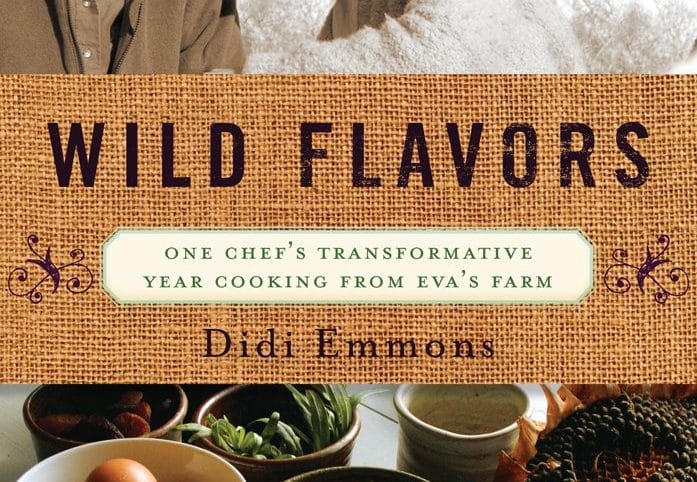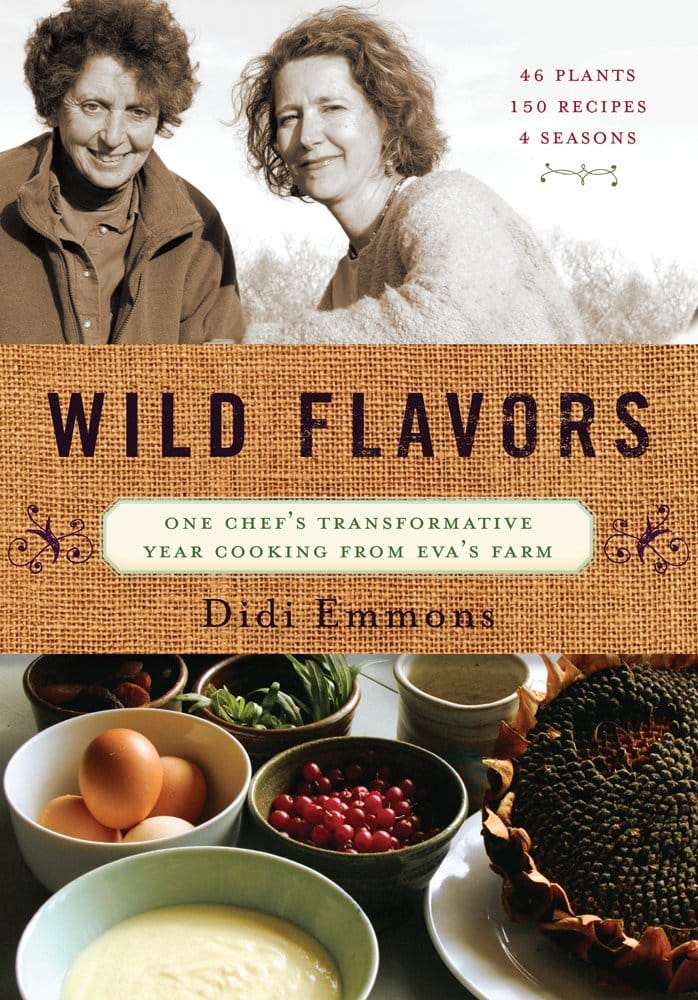by Didi Emmons (Chelsea Green 2011) 285 pages, 150 recipes
In 2001, Didi Emmons, who had just opened a restaurant in Cambridge, Massachusetts, received a note from Eva Sommaripa, inviting her to purchase herbs from her oceanside farm 80 miles southeast of Boston. Emmons’ visit to Eva’s Garden was life-changing. On her first visit she wandered the farm alone, astonished at the dizzying variety of herbs and vegetables, many of which were unfamiliar to her.
Didi and Eva became good friends. Over the course of the next ten years, Didi made frequent weekend visits to the farm, learning from Eva how to creatively combine the complex and intense flavors of freshly-picked produce. Wild Flavors is the result of those ten years of friendship and education. Organized around the four seasons and four of Eva’s core principles, each of the four chapters offers detailed descriptions of plants and their uses, recipes, thoughts on sustainable farming, anecdotes, advice, and numerous color photos.
The theme of the chapter on winter is salvaging. Abhorring waste, Eva composts, barters, recycles, forages, and reuses. Visiting Didi when she stayed in Eva’s guest cottage, Eva would rummage through Did’s trash can as they chatted, exclaiming at what she found there that could have been composted (pizza crust) or reused (plastic forks). Recipes for winter include cold-weather vegetables like cabbage and rutabaga, root vegetables, venison, Juniper Berry Paste for Meat and juniper berry seasoned shortbread cookies.
Spring is about community, neighbors getting together after the winter to garden and celebrate relationships. Plants include alliums (onions) and green garlic, herbs like bolted oregano (bolting is when a plant produces a flower stem before going to seed), cilantro berries (edible berries found on mature plants), curly dock and goosefoot (both plants that can be foraged), lovage, and more. Recipes include Pasta with Rhubarb, Swiss Chard, and Bacon, Spruce Shoot Compote, and Stinging Nettle Soup (which can also be made with Swiss chard or spinach).
The theme of summer is bartering. Eva, who has not been in a supermarket in over ten years, trades and shares food, bartering her produce for farm-raised meats, eggs, olive oil, wild game, seafood, wine, and imported products. Recipes for summer emphasize herbs: lavender, basil, anise hyssop, rugosa rosa, and others. Pesto is made from sage and mint, ratatouille with fennel and tofu, sorbet with calaminth. There are instructions for making butter with edible flowers and lemongrass ice cream. A recipe for potato and smoked bluefish stew is seasoned with summer savory. Particularly helpful is advice about how to snip herbs from the garden and how to harvest at the end of the season.
Fall is about preserving and conserving. The flavor of many vegetables becomes sweeter and more intense in cold weather. Autumn olive is an invasive shrub that produces edible tart-sweet berries in mid-fall that can be foraged and used in savory foods and desserts. The berries can be cooked and strained to remove the seed in the center of each one, then the pulp can be frozen or made into fruit leather or jam (recipes provided) and the nectar canned.
Fall recipes include White Bean and Cardoon Minestrone, Chickweed Apple Slaw with Ginger Dressing, and Sunchoke Dumplings with Swiss Chard and Walnuts. If you’re plagued with chickweed invading your garden, you’ll be glad to know it can be used in salads and is sold to chefs under its Latin name “stellaria.” Recipes show you how to add it to a harvest salad, grilled cheese sandwich, or apple slaw.
The recipes in Wild Flavors are easy to execute, healthy, and highly flavorful. I marveled at how simple it was to make Roasted Parsnip Soup, which is essentially roasted vegetables pureed with water. This thick, smooth, vegan soup has intense flavor from the caramelizing of sweet parsnips, made complex by the addition of roasted potatoes, onion, and garlic.
Other recipes are similarly impressive. Mo’s Harissa is made from peppers and tomatoes that are roasted to intensify the flavors, then pureed with dried chiles, honey, herbs, and oil and vinegar. I used it both as a marinade and a condiment for broiled tofu, and was able to freeze the remainder for another time. ![]()
First published April 2014

